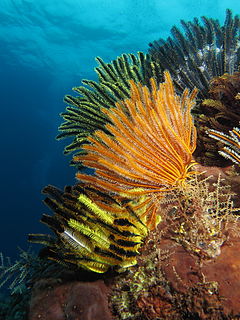Crinoids have a central mouth (charmingly, with their anus right beside it) surrounded by waving tentacles. They are also called sea lilies, feather stars, or comatulids.
Most crinoids are free-swimming, but some look a bit like sea anemones (but they aren't: the way their stalks grow mean that they're actually the other way up to sea anemones).

These stalked crinoids were drawn by Ernst Haeckel

Colourful crinoids in Indonesia, photo by Alexander Vasenin
Now, crinoids are obviously well worth spotting, but that's not going to be easy for most of us. Luckily crinoid has another meaning, which is shaped like a lily.
So, obviously, this is crinoid:

photo by UpstateNYer
And so is...um...whatever this is:

The Shapla chattar in Motijheel Dhaka, Bangladesh. Photo by Abu Nayeem
as if this:

The Lotus Temple in New Delhi, India. Photo by Nikkul
Fleur-de-lis must be crinoid:

That was the shield of Bosnia Hertzogovina in the 1990s. Image by Vernes Seferovic
The throats of young ladies are also sometimes said to be lily-like, but that's really rather creepy (and presumably more to do with texture and colour than shape).
On the whole, I think I'm going to peer through the windows of a few florists.
Spot the frippet: something crinoid. This word comes from the Greek krinoeidēs, which means lily-like.
No comments:
Post a Comment
All comments are very welcome, but please make them suitable for The Word Den's family audience.